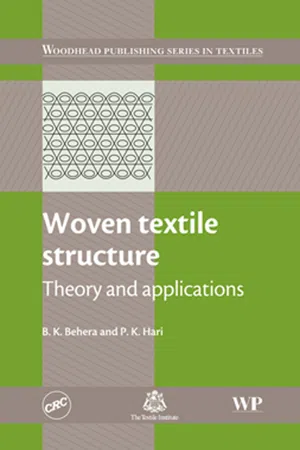
- 472 pages
- English
- ePUB (mobile friendly)
- Available on iOS & Android
About This Book
Understanding and predicting the structure and properties of woven textiles is important for achieving specific performance characteristics in various woven applications. Woven textiles are used in a range of products such as apparel, technical and industrial textiles. Woven textile structure: Theory and applications provides comprehensive coverage of the structure, behaviour, modeling and design of woven fabrics and their relevance to the textile industry.The first group of chapters review the fundamental principles of woven fabric structures. Part two discusses the mechanics of woven fabrics, topics include shrinkage in woven fabrics, yarn behaviour in woven fabrics and bending behaviour of woven fabrics. Part three presents a selection of chapters on design engineering of woven fabrics, themes such as textile product design methods and modelling for woven fabric design are covered. A final group of chapters is dedicated to addressing practical applications of woven fabrics.Woven textile structure: Theory and applications is essential reading for designers, engineers and technicians involved in the design, manufacture and use of woven textiles and garments. It will also bebeneficial to academics and students.
- Provides comprehensive coverage of the fundamentals of woven fabric structure including geometrical modeling
- Examines mechanisms of woven fabric structure featuring shrinkage, buckling, bending and creasing behaviour of textiles
- Illustrates mathematical modeling and building predictive models for textile product design incorporating validation and testing
Frequently asked questions
Information
The basics of woven fabric structure
Abstract:
1.1 Introduction: woven fabric formation
Table of contents
- Cover image
- Title page
- Table of Contents
- Copyright
- The authors
- Woodhead Publishing Series in Textiles
- Preface
- Part I: Fundamentals of woven fabric structure
- Part II: Mechanics of woven fabric structure
- Part III: Design and engineering of woven fabrics
- Part IV: Practical applications
- Index